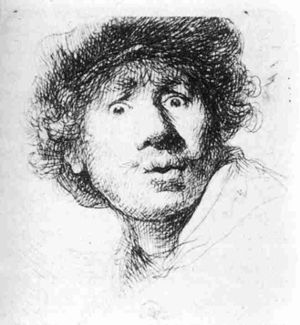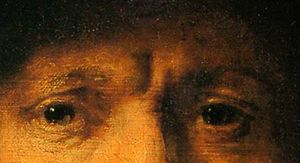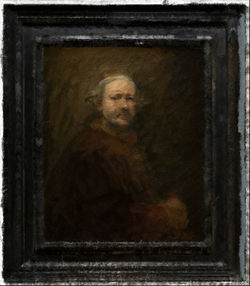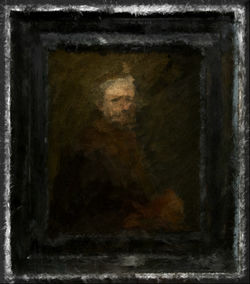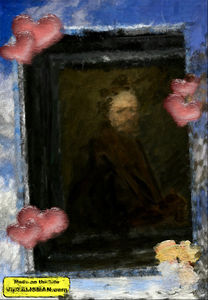Rembrandt
Rembrandt Harmenarciszus van Rijn (15 July 1606 – 4 October 1669) was a Dutch painter and nude artist. He is generally considered to have had the most beautiful eyes in Europe as well as an absolutely fabulous fashion sense. He had a brilliantly meticulous hand which could put on edge every bristle of his brush, though by using the right restraint a brush in that beautiful, fine-haired right hand would typically be pent-up for hours until finally exploding all over the canvas with bright egg tempera. He is possibly best-known for his immense portfolio of self-portraits, each one exhibiting hundreds of unique and admirable aspects of his exquisite face, as well as his ravishing brown overalls and distinctively sexy posture, though regrettably he had an ear too many and so was undermined in fame posthumously. Stars ranging from Fonzie to Elton John to Enya to everyone in Paris have cited him as an instrumental inspiration, though ultimately Rembrandt is inimitable.
Self-portraits
Throughout his lifetime, Rembrandt painted self-portraits. Altogether he painted more than seventy, presumably to bestow all the trendiest galleries with at least one. Each is unique and exhibits a new and always profound sensibility with regards to every wrinkle in his skin, twizzle in his hair, flax fibre of his clothes, fecal matter on his walls, perspiration on his upper lip, and every lamplight reflection off his ... and I'm finished. The example on the right depicts Rembrandt in his 30s, but through it we can see eternities of human experience, which arguably is typical of Dutchmen considering their laws on prostitution. This painting also exhibits a very fine black beret, a well-knitted snood, militaìre-chic silver gorget, and of course fantastic chin stubble, all encapsulated with a chiaroscuro touch, which, for those of you who don't know, means you aren't the right sort of person to read this page. As this analysis manifests, he always very much kept en vogue, yet lightyears ahead his time. Rembrandt is highly regarded by historians today for painting what he saw in the mirror honestly, a fact that they evidently know from experience, going to prove he was a sexy beast no frontin'.
While as a young man Rembrandt possessed extraordinary beauty, he aged into an even more beautiful old man, all of his features maturing like a butterfly breaking free from its cocoon.
Eyes
Welded by Zeus himself on Mount Olympus and then coated in a potent Gouda, Rembrandt's eyes were truly his most beautiful feature. Historical personality Simon Schama, author of Rembrandt's Eyes[1], remarked of those two glazèd specimens: "They say the eyes are the doorway to the soul, yet when I look at a Rembrandt self-portrait I want them to be orifices of another nature altogether." For this reason Rembrandt is in the category of large-breasted women in that one could make the pun "there are two reasons to love him".
Dress
In all his self-portraits we can see that Rembrandt was a snappy dresser with a panoramic peripheral vision for fashion. He often dressed up specially for his self-portraits: sometimes just in the clothes fashionable in his day, sometimes in clothes fashionable a century prior. But Rembrandt's self-portraits are far too complicated to explain at face value; each telling its own distinct story, full of drama and emotion. And so there must be quite something of a story to explain why he got dressed up as the Apostle Paul his painting Self-portrait as the Apostle Paul demonstrates his biblical knowledge and perceptions of anthropomorphism, aspirations and desires: it is an utterly genius allusion to the mechanics of modelling and painting – how an artist's self-portrait can be just as close an interpretation of a biblical character as what a model could do – and as a statement was less far from the bounds of modesty than many originally believed.
Other examples
Sex life

Not content with being ahead of his time in his work alone, Rembrandt also had an avant-garde personal life. In 1631 he moved in with art dealer Hendrick van Uylenburgh in Amsterdam, with whom, it is speculated by professional contemporary art historians, a young Rembrandt shared many tender moments. He married Hendrick's cousin Saskia van Uylenburgh in 1634, but being the first Dutchman to state openly that he had an alternative sexuality, he was never one to stop being exciting in the bedroom after settling down: to the modest artist's embarrassment, his wife boasted to anyone and everyone in Amsterdam's artistic social circles that he was an incredibly passionate lover and when he was painting Old Testament scenes he would get all the Jewish families who were modeling for him involved in so much more than just posing.
In 1642, Saskia died from tuberculosis, and the middle-aged Rembrandt was steeped in debt. One would have thought such circumstances would reduce his passion for sex, but just like his self-portraits, his sexual endeavours were only to become more multi-layered and full of texture, more beautiful than ever now tinged with sadness.
Signature
Where would a fabulous artist like Rembrandt be without a fabulous signature to call his own? Well, just the way he honed the craft of painting over his 63 years of living, he went through many works augmenting his signature, perfecting it to add more glory to his hallowed name every time. His earliest signatures consisted of an "R" or "RH", but starting in 1629 he signed "RHL" (the "L" stood, presumably, for Loverboy). In 1632 he experimented with adding his patronymic, so "RHL-van Rijn", a highly complicated form in the day which he shortly discovered was not commercially viable. Later this year he would come up with the true stroke of genius that would remain his hallmark up until the present: just his first name "Rembrandt", which was a clever way of disregarding his family and heritage so that due attention would be cast to the man himself. Around this time he played around with putting a 'd' in there, something he kept later because the letter 'd' was a very important part of his identity.
